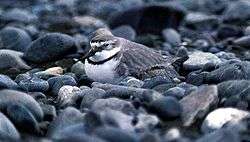Wrybill
| Wrybill | |
|---|---|
 | |
| Wrybill sitting on eggs | |
| Scientific classification | |
| Kingdom: | Animalia |
| Phylum: | Chordata |
| Class: | Aves |
| Order: | Charadriiformes |
| Family: | Charadriidae |
| Genus: | Anarhynchus Quoy and Gaimard, 1830 |
| Species: | A. frontalis |
| Binomial name | |
| Anarhynchus frontalis Quoy and Gaimard, 1830 | |
The wrybill or (in Māori) ngutuparore (Anarhynchus frontalis) is a species of plover endemic to New Zealand.[2] It is special since it is one of the two species of bird in the world with a beak that is bent sideways (it is always to the right for wrybill, and the other species is Loxia pytyopsittacus). A 2015 study found it to actually be within the Charadrius clade, with its closest relatives other plovers found in New Zealand, the nearest the New Zealand plover or New Zealand dotterel (Charadrius obscurus), and then the double-banded plover or banded dotterel (Charadrius bicinctus).[3]
It lays its eggs among the rocks along rivers and distracts intruders by pretending to be in distress and moving away from its "nest".
Description

The wrybill is a small, plump plover, measuring 20 to 21 cm (7.9–8.3 in) in length and weighing between 43 and 71 g (1.5–2.5 oz). The plumage is slightly sexually dimorphic. The male has a white forehead and pale grey crown, nape, back, wings and tail and a white throat, breast, belly and rump, with a thin black band across the breast. This band is thinner in the female, and much less distinct in both sexes in the non-breeding season. The other difference between the sexes is a small black bar between the white forehead and the grey crown, which is present in the males but not the females. As with the breast band it is reduced in the non-breeding season. The most distinctive feature of the bird is the long black bill, which is always curved to the right. The wrybill is the only species of bird with an asymmetrically-turned bill.[4]

Distribution, habitat and movements

The wrybill is endemic to New Zealand. It breeds on large braided rivers in central South Island, preferring large dynamic rivers that will not become overgrown with weeds. It used to occur more frequently on smaller rivers, but has undergone a range contraction, and now only occupies around 60% of its estimated original range.[5] After breeding, around late December till early February, they leave their breeding sites and migrate to shallow estuaries and sheltered coastal areas in the North Island.
References
- ↑ BirdLife International (2012). "Anarhynchus frontalis". IUCN Red List of Threatened Species. Version 2013.2. International Union for Conservation of Nature. Retrieved 26 November 2013.
- ↑ Barrie Heather and Hugh Robertson, "The Field Guide to the Birds of New Zealand"(revised edition), Viking, 2005
- ↑ dos Remedios, Natalie; et al. (2015). "North or south? Phylogenetic and biogeographic origins of a globally distributed avian clade". Phylogenetics and Evolution. 89: 151–159. doi:10.1016/j.ympev.2015.04.010.
- ↑ Olliver, Narena (2005), "Wrybill, Anarhynchus frontalis", New Zealand Birds, New Zealand Birds, retrieved 2010-07-25
- ↑ Ministry for the Environment; Manatü Mö Te Taiao (2007). Environment New Zealand 2007 (PDF). Ministry of the Environment. p. 388. ISBN 978-0-478-30192-2.
